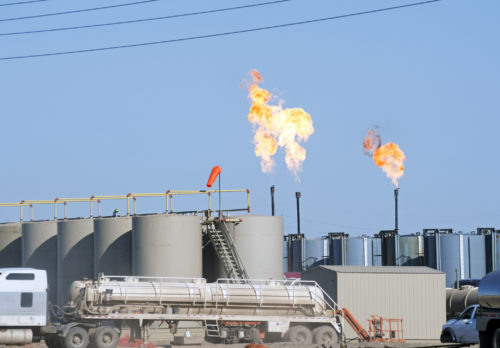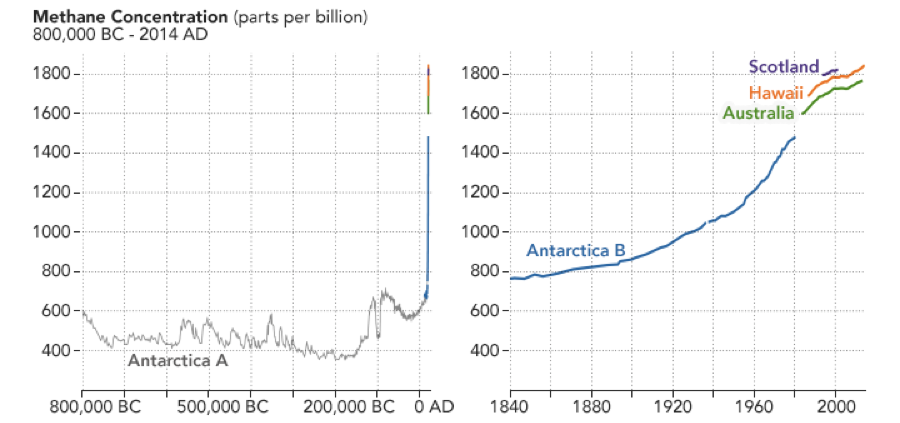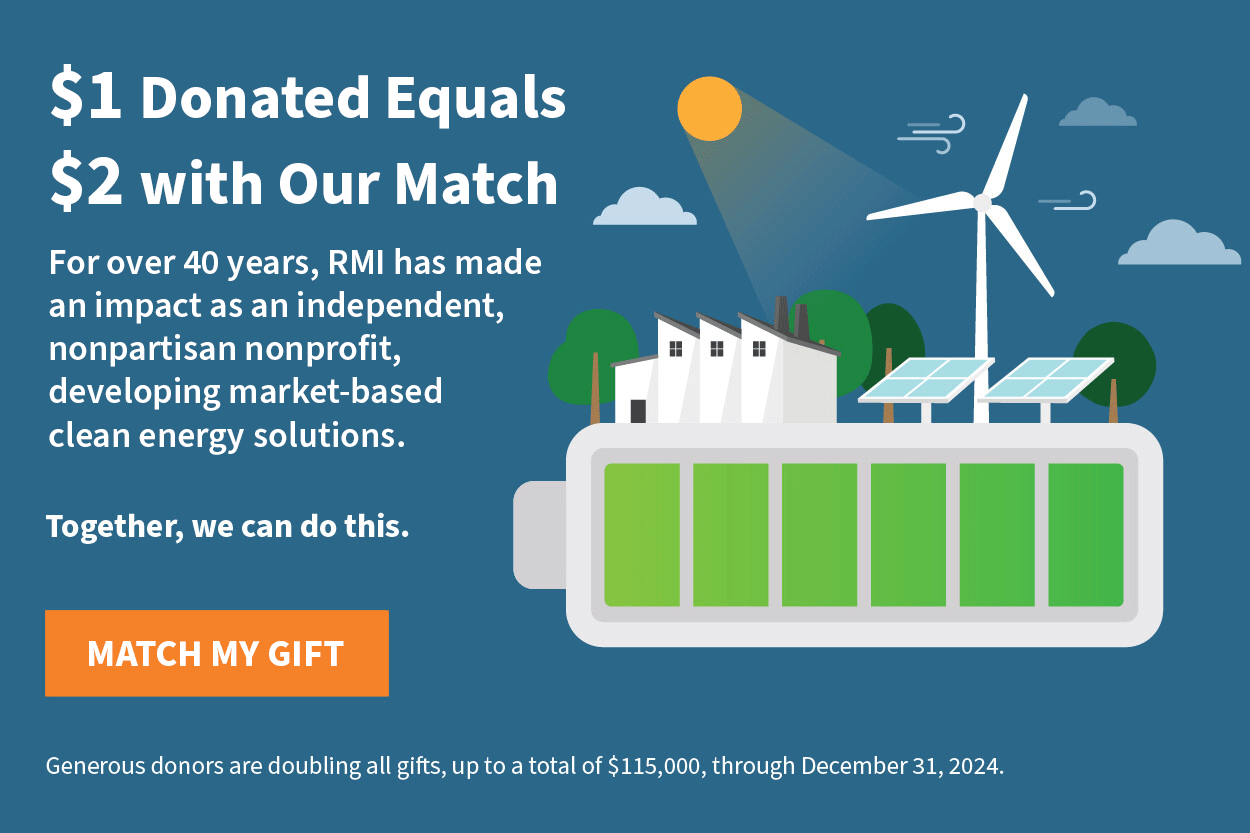
Cutting Methane Emissions from Oil and Gas Production: One of the Year’s Biggest Energy Challenges
Leave it to the rocket scientists to solve our biggest climate mysteries. That’s exactly what NASA has done to kick off 2018, using a spectrometer imaging satellite to measure global methane emissions—a potent greenhouse gas that accelerates climate change—and revealing an alarming increase in these emissions that threatens our climate.

The Intergovernmental Panel on Climate Change (IPCC) has shown that since preindustrial times, methane has been responsible for 20 percent of global warming and nearly 40 percent of the climate forcing, a direct measure of the amount that the Earth’s energy budget is out of balance. Methane currently contributes almost 40 percent to the heat-trapping effect of all human-produced greenhouse gases in the atmosphere.
And this problem is only getting worse. As NASA explains, since just 2006, methane concentrations in the atmosphere have risen sharply and are currently causing an overbalance of more than 25 million tons per year. Clearly this cannot continue if we have any hope of limiting global temperature rise to 2 or even 3 Celsius degrees, as outlined in the Paris Climate Accord.
Enter the recent NASA study. Its research confirms that 17 of the extra 25 million tons of annual methane emissions come from the fossil fuel sector—or nearly 70 percent of all new emissions! During this period, there has been a massive increase in hydraulically fractured oil and natural gas production while coal mining has remained constant. In addition, natural gas wasted in unproductive flares and vents to the atmosphere have been on the increase for the past eight years. By inference, the increase in both petroleum production and the intentional wasting of the associated gas provides a smoking gun to the spiking atmospheric concentrations of methane. Reliable methane emissions estimates in the oil industry are lacking since measurements of partial combustion and vents are close to absent, and measurements of gas leakage from transport and distribution are scarce.
The Problem…
Methane emissions from oil and gas production and distribution is a widespread problem that persists up and down the supply chain. As oil is produced, a portion of associated or byproduct gas is commonly vented or wasted in flares, resulting in the release of a substantial amount of methane. A recent Stanford University and Environmental Defense Fund (EDF) study found that oil and gas well pads with high emission rates disproportionally contribute to total methane emissions. A follow-up study concluded that the largest 5 percent of leaks typically contribute over 50 percent of the total leakage volume. The studies indicated that these “super emissions” are missing from inventories. Nationally, 4 percent of sites have such high-emitting sources, ranging from 1 percent in the Powder River (Wyoming) to 14 percent in the Bakken (North Dakota).
In another recent study, researchers at Purdue University and EDF concluded that natural gas power plants release 21 to 120 times more methane than EPA estimates, and oil refineries’ emission rates are 11 to 90 times more than initial estimates.
Other parts of the natural gas supply chain that are enormously energy intensive, such as natural gas liquefaction (LNG) transport and regasification, have not yet been adequately measured for methane vents and leaks. This part of the supply chain is growing rapidly. The environmental efficacy of LNG is already questionable due to the significant energy required to turn methane to liquid. If these LNG systems also leak methane, they become indefensible in a carbon-constrained world.
Simply put, the high levels of methane emissions from the oil and gas industry are responsible for one of the most urgent climate “forcing” problems we face today. Natural gas, long touted as a cleaner and more climate-friendly alternative to burning coal, is expected to continue to increase as market forces drive the replacement of coal. However, methane leaks of just 3 percent from the natural gas supply chain double the carbon impact of gas, rendering it on par with coal from an environmental perspective. How does this bode for the future?
Outlook…
The International Energy Agency’s (IEA) November 2017 World Energy Outlook provides two scenarios for future energy use to 2040. The “new policy scenario” achieves what we have today in GHG emissions. This scenario is a non-starter leading to unrelenting climate chaos.
By contrast, the IEA’s “Sustainable Development Scenario” (our only hope for a productive future) projects a significant CO2 downturn with major electric vehicle penetration, massive gains in efficiency, and enormous growth in renewables. However, this happy reduction is predicated on 580 billion cubic feet per year of increased gas consumption on top of the 3,500 billion cubic feet of gas currently being used, and almost doubling LNG production by 2040. All this methane is assumed to provide a 50 percent GHG reduction as it replaces coal. This “Sustainable Development” prediction makes the big assumption that, in the very near future, there will be negligible (near zero) methane leaks and vents from the oil and gas industry.
Near zero vents and leaks seems like an implausible assumption and an impossible task. Except that there are parts of the oil and gas supply chain that have already achieved near-zero methane emissions. Where deadly poisonous hydrogen sulfide (H2S) is produced with oil and gas, the oil industry has developed zero leak systems and technology. The problem is these systems are not used where H2S is absent.
Therefore, achieving the goal of near-zero methane emissions across the entire natural gas supply chain from production to post combustion will require the oil and gas industry to kick off an unprecedented number of methane emission abatement projects. In addition, the industry will need to rapidly integrate new technology to make the supply chain 100 percent tight and methane combustion 100 percent complete.
The good news is that according to the IEA, 60 percent of methane abatement projects will actually make money. The IEA estimates that substantial dividends to investors have been left unrealized for years. To reap these economic and environmental benefits, industry leaders need to shift their mindset, opening up the market to entrepreneurs and outside financing to help foster a gold rush of methane abatement activity.
It’s Time for Action
Too many scientifically based studies have been published to continue to ignore the problem of methane emissions from the oil and gas industry. The time to fix this problem is now. Our best chance to address runaway methane emissions is to tighten up the oil and gas supply chain where large amounts of methane are intentionally vented and unintentionally leaked. Rocky Mountain Institute’s Global Race for Zero Methane Emissions Challenge is doing just that, aiming to reduce climate-change-causing methane impacts of the oil and gas industry by 5.6 billion metric tons of CO2 equivalent emissions.
Starting with major oil and gas companies, methane reduction must become the oil industry’s priority, as opposed to being treated simply as a regulatory hurdle. To this end, there are some encouraging signs of commitment by certain companies that recently signed a set of Methane Principles. However, this commitment must be followed up with real action in the form of tens of thousands of methane abatement projects across the oil and gas supply chains.
To make these projects happen faster, petroleum ministries and national and international oil companies need to reexamine their 100-year-old business models and open up their protected markets to entrepreneurial forces. To solve the industry’s methane problem, the industry needs to mobilize a “gold rush” of activity that is supported by national budgets, multilateral financing, and commercial banks.
It is clear that in our carbon-constrained world, methane emissions are now an intrinsic threat to the oil and gas industry. It is therefore imperative that this industry commits the resources in all forms now to address this enormous risk to their business and, more importantly, our common future.
Image courtesy of iStock.
